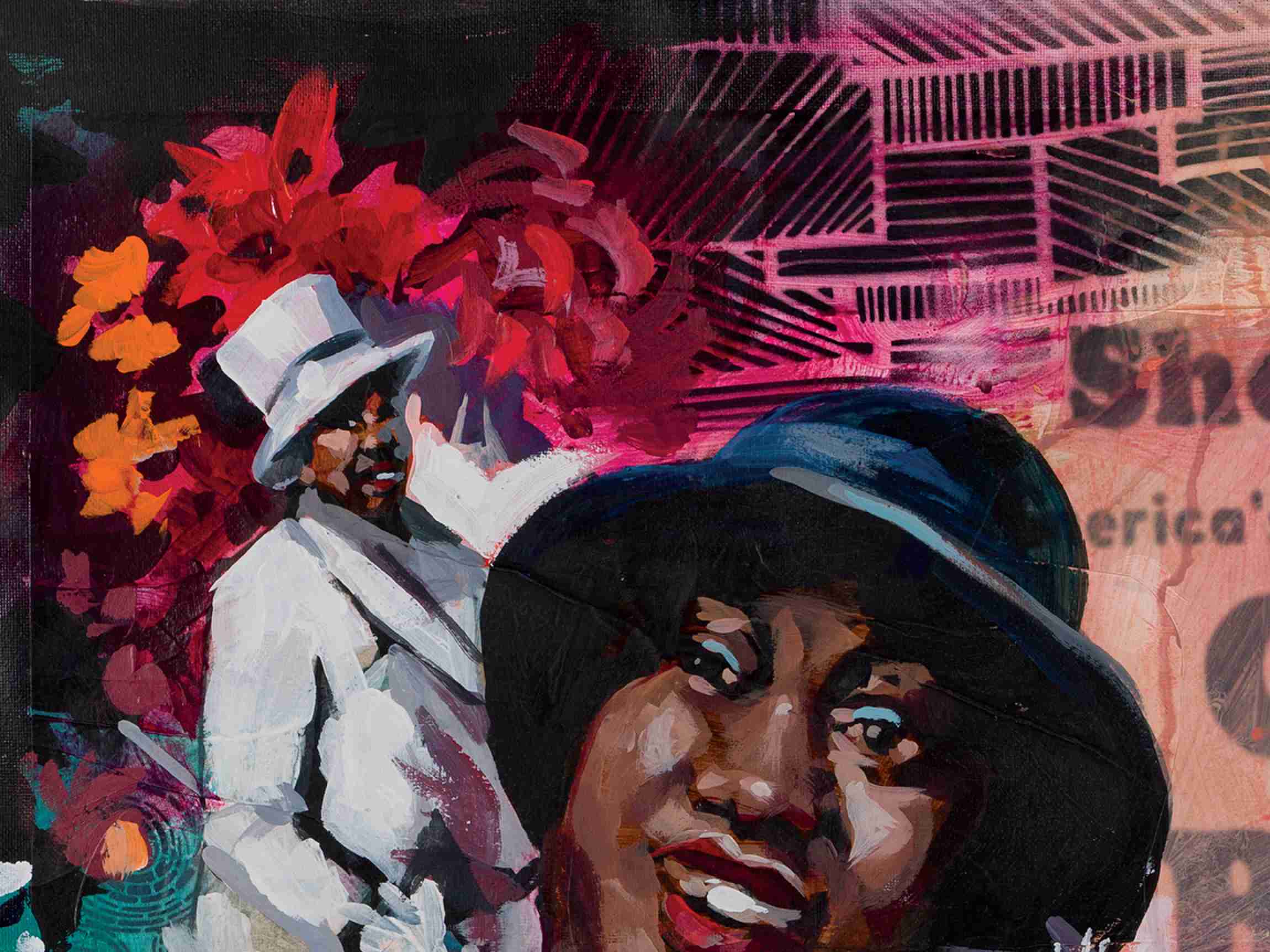

GLADYS BENTLEY
BORN: AUGUST 12, 1907, PHILADELPHIA, PENNSYLVANIA
DIED: JANUARY 18, 1960, LOS ANGELES, CALIFORNIA
SINGER, MUSICIAN, ENTERTAINER
“A MOTHER ALWAYS KNOWS HER CHILD.” I’ve heard this saying time and time again in my life, and for many of us it has felt more like fact than fable. But what happens when a mother refuses to accept her child for who they are? How does that child navigate the world, especially when their queerness shows up very early in life? What happens to the queer child who can’t find love in society or at home? Those were life’s questions for Gladys Bentley.
Gladys, the first of her mother’s four children, was born to a poor family. But Gladys was immediately rejected by her mother—for not being born a boy.
She said in a 1952 interview for Ebony magazine, “When they told my mother she had given birth to a girl, she refused to touch me. She wouldn’t even nurse me, and my grandmother had to raise me for six months on a bottle before they could persuade my mother to take care of her own baby.”
By the time she started elementary school, Gladys knew she was different. She didn’t want to wear girls’ clothes, so she dressed in her younger brothers’ suits and pants. She was entranced by her female teachers even though she couldn’t name what those emotions meant for her.
Because she refused to conform to gender norms, her family eventually sent her to doctors to be “fixed.” This “fixing” was what we’d call today conversion therapy—a pseudoscientific practice (meaning one not based in science) of trying to change someone’s sexuality, gender identity, or gender expression to align with heterosexuality.
Some of the therapies of that time could be more psychosocial, like spiritual interventions, counseling, and social skills training. However, there are also horror stories about ice-pick lobotomies (operating on the brain with an ice pick through the eye socket), chemical castration using hormone treatments, and even electric shock to genital areas.
Not much is known about what specific “fixing” Gladys went through, but we do know that it didn’t work. It never works; it only makes a person fear their identity, not change it. Conversion therapy, pretty much a junk science, has been deemed harmful, even dangerous, by the American Medical Association. Can a person choose to not act on their innate feelings toward the same sex or differing gender identities? Sure. But that does not equal a “cure.”
At sixteen, Gladys left home for New York City. She became a piano player and singer. Then one day she saw a job opening for a male piano player at a speakeasy in Harlem known for being gay-friendly. Speakeasies were a style of nightclub that illegally sold alcohol during Prohibition. She decided to start dressing in men’s clothing and performing in men’s attire. She got that job, and her life took off. It was around that time she also became known for being a little risqué in her acts. She sang about sex and called out men using terms like sissies and bulldaggers—slurs people used at that time toward effeminate men and masculine women.
Once again, the interconnectedness of the Harlem Renaissance is made clear through an essay by Langston Hughes, “When the Negro Was in Vogue.” In it, Langston refers to Gladys as “a perfect piece of African sculpture, animated by her own rhythm.”
I love that Gladys was unapologetic about not being defined by her perceived masculinity (which is how many described her appearance and performances). She remained true to her identity. In reality, the notions of masculinity and femininity are constructs that shouldn’t even exist, as there is no way to truly measure them. Societies define what is masculine and feminine; it’s not a science. For example, men in medieval Europe wore tights and it was not deemed effeminate, though today in many societies it might be. In the 1920s and ’30s, many places thought it was too masculine for women to wear pants and saw it as a sign of rebellion. This can be true even today, but in most cultures pants are no longer a gendered garment.
Gladys wasn’t trying to pass as a man. She was doing what she felt was natural to her. When we break out of the boxes heteronormativity places us in, we shine with creativity and diversity. That’s the beauty I see in queerness. To be clear, even today we still have many issues in the LGBTQIA+ community around masculinity and femininity and who gets to perform them. Many people feel forced to tone down their masculine or feminine traits because they fear they will be judged, seen as undesirable, or physically threatened. But there are many who, in the face of this danger, still choose self over societal boxes. And Gladys was one of those pioneers.
At the same time, her career intersects in an interesting way with the denial of women’s sexuality in music. When we look at women in rap, they are always condemned for being overly sexual, whereas men in rap have never faced the same critique. Gladys Bentley was raunchy. She imbued her songs with sex. In one of my favorite lyrics from “Boogie’n My Woogie” she sings, “Roses are red, violets are blue, if you take my man, I’ll take yours, too.” I’m reminded of the song “I’ll Take Your Man” by Salt-N-Pepa, and the updated version by the City Girls. It serves as a reminder of how connected we are to our past, and how what many deem new or inappropriate is just the evolution of a culture we have always owned.
Gladys was known for her stirring songs, her piano playing, and her “cross-dressing” masculine appeal. She performed at Harry Hansberry’s Clam House early on in her career, using the stage name Barbara “Bobbie” Minton. She became so popular they changed the name of the club to Barbara’s Exclusive Club. After becoming wealthy, Gladys purchased an expensive New York apartment and kept servants on staff. She also recorded several albums that appealed to white, Black, gay, and straight audiences across the country.
Her career only started to slow after the end of Prohibition, which caused the closing of many speakeasies—popular venues for her. Unfortunately, this affected many performers during that time, and made it hard for Gladys to find work.
Gladys had several lesbian relationships, and even had a civil wedding ceremony in the 1930s to a white woman. For most of her life she had a real hatred of men—stemming from the trauma of her mother wanting her to be a boy. And this is where my thoughts start to wander some. Was her performance of masculinity about being her true self? Or was she always chasing her mother’s one dream? Chasing her mother’s love.
After the height of her fame, Gladys began wearing dresses and removed the raunchy content from her act. She also began caring for her aging mother, as she felt a good daughter should. This significant change in behavior could be earning her mother’s approval and/or the societal pressures against queerness. It could have also been caused by federal legislation that passed during this same time. In 1953, President Dwight Eisenhower signed an executive order banning all homosexuals from working in the federal government. Sodomy laws also existed in all fifty states; these laws banned certain sexual acts, primarily between same-sex couples, but they could affect people of different sexes and married couples as well.
The Joseph McCarthy–era “witch hunts” in the late 1940s and through the 1950s—which essentially encouraged the public reporting of queer people, communists, or anyone deemed culturally subversive—led to many “out” homosexuals from the Harlem Renaissance going back into hiding or denying their homosexuality in public. During this era, homosexuality was classified as a psychiatric illness, and people could be imprisoned or forced into conversion therapies.
In an article she wrote for Ebony magazine titled “I Am a Woman Again,” which many believe she fabricated for her own safety, Gladys wrote about being cured by female hormones to correct her homosexuality. At this time, Gladys married a man nearly sixteen years her junior. She continued to perform at small ballrooms in California until her death in 1960, but her career never returned to its earlier heights.
In that same Ebony article, she wrote, “For many years, I lived in a personal hell. Like a great number of lost souls, I inhabited that half-shadow no-man’s-land which exists between the boundaries of the two sexes.”
Religion and society can have a damning effect on queerness. In conservative contexts, not having boundaries for your gender or sex is the equivalent to hell on earth and even in the afterlife. Gladys Bentley was likely a hero to others who felt just like her. I wish the love she received from so many of her fans could trump that one love she chased in her mother. Her story still serves as the reminder of how great one can be when they choose to live their life as they are.